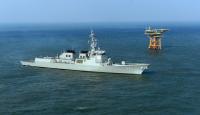
South Korean Aegis destroyer Yulgok YiYi patrols the waters around Socotra Rock, south of Jeju Island, on Dec. 2. Photograph by Yonhap via EPA
On Sunday, the government of South Korea announced that it was extending its air defense zone to include Socotra Rock, a submerged pinnacle in the Yellow Sea. The Korean air defense zone now overlaps with the air defense zones already claimed by both China and Japan and is expected to increase tensions in the region. Both Korea and China had already claimed the rock as part of of each countrys’ “exclusive economic zones,” (EEZ).
Socotra Rock is fifteen feet below the surface at low tide and yet, is the subject of legends. The rock was discovered by the British merchant ship Socotra in 1900 roughly 150 kilometers southwest of the Korean island of Jeju. The fisherman of Jeju have a legend of an island where the spirits of fishermen who perished at sea went to dwell. The mythical island was called both “Parangdo” and “Ieodo.” With the discovery of Socotra Rock, the South Korean government claimed a direct connection between these legends and the rock, claiming that the traditional saying that “One who sees Parangdo would never return” refers to the danger facing sailors when high waves allow the rock to break the surface. The South Korean government, referring to the rock as Ieodo have claimed it as part of their territory since 1952, a claim which has never been recognized by China. In 1995, the Ieodo Ocean Research Station was built on a platform above the rock.
This is not the first time that Socotra Rock has been the focus of an international concern. In 1963, the Chinese ship Yuejin sank on her maiden voyage. The crew of the ship claimed to have been attacked by a torpedo but further investigation showed, due to an error in navigation, the ship had struck Socotra Rock.
